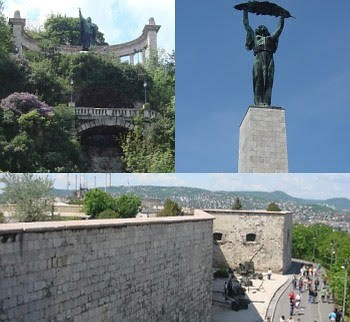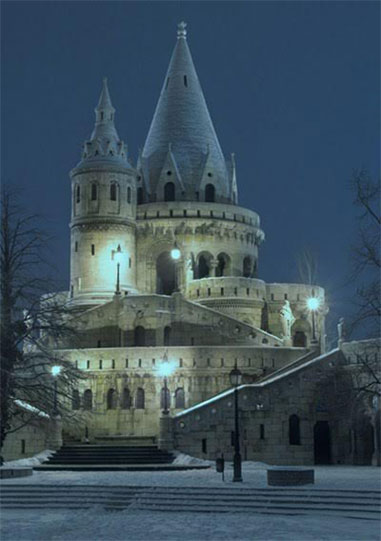

Budapest certainly has enough sights to satisfy. From majestic city vistas to beautiful ancient architecture to abundant shopping.
Budapest is full of sights so if you only have a limited time the best place to start is from as high up as you can. Luckily you can start your sight seeing before you even get off the plane. Some of the airlines, in particular Hungary’s own Malev tend to fly directly over Budapest on their way in to Ferihegy Airport’s Terminal 2. If you turn up early enough for check in you should be able to get a window seat but make sure it’s on the right hand side of the plane. Then all you need are clear skies and you’re in for a real treat as the aircraft begins it’s final approach, dipping its wing to give a fantastic view of the Danube, the parliament and most of the bridges. Watch out too for the large dumbbell shape of the outside pools of the Szechenyi thermal baths.
Immediately recognizable by one huge statue of a stocky woman holding a palm frond and seemingly turning her back on most of Budapest, Gellert Hill affords some spectacular views of the city. Taking in four of the bridges straddling the Danube, the parliament, most of Pest as well as the Castle on the Buda side. Up there you’ll also find the Citadel which was built by the Austrians mid 1800 to intimidate the locals. Now it houses restaurants and a war museum and is heavily supported by an army of souvenir merchants apparently meeting the heavy demand for lace and leather products. You can take the trip up the hill by foot if you’re fit, taxi for a fiver or the number 27 bus for next to nothing. The best time for the view is to arrive just before sun down when the city starts to light up. You can see the view first from this handily placed web cam on top of Gellert Hill. The Chain Bridge is straight ahead, the Royal Palace is to the left on the hill and the Parliament can just been seen on the right hand bend of the river behind the Chain Bridge.
The ornate gateway to the ancient Castle district, the Fisherman’s Bastion offers views immediately over the Danube to the Pest side


Another great look out on the Buda side and this time surrounded by a wealth of old time sights of its’ own. If you turn immediately behind you after you’ve seen the view, walk past the first junction and continue on to a statue of a horse. The tradition is for those coming first and last of every graduation from the university to climb up and polish a certain part of the horse. We’ll leave you to find out just which part. Oh, and there’s St Matthias church up here as well which is very famous.
The first time we visited here we were shocked at just how clean and graffiti free everything is, especially coming from downtown Pest where the place is a riot of graffiti tags on every reachable space. There are plenty of tourist shops here but also a fine collection of up market restaurants and hotels (good value can of course be found elsewhere).
The most prominent structure sitting directly on the banks of the Danube in Budapest borrows architectural features from London’s own Houses of Parliament


Budapest certainly has enough sights to satisfy. From majestic city vistas to beautiful ancient architecture to abundant shopping.
It’s a monster! Dominating most of the views listed above is Hungary’s supreme statement of independence. It’s reflection in the Danube conjures memories of its’ architectural grand-father, the houses of Parliament in London. Built in only 17 years, and recently cleaned of the coal dust that used to cover the entire city, it was once the largest parliament building in the world. 27 entrances and over 600 rooms, it also houses the Hungarian Holy Crown (with the bent cross) and insignia. If you have the time it’s well worth taking a tour which costs around £6 per person starting at entrance 10.
Marvellous architecture, stunning interiors, breath taking views and an animated mummified hand, all good reasons to visit the St Pauls of Budapest


Before the West-End Shopping Centre started running balloon rides, the Basilica, Budapest’s largest church, built between 1848 and 1905, provided the best view in Pest. If you’ve the energy for the stairs, and if not there’s a lift that will take you most of the way, you can still enjoy the view and, indeed, a very fine church into the bargain. Located right in the vibrant cafe-bar-restaurant district it’s a good opportunity on first arriving in the area to really get your bearings. Complete tours, which are not compulsory, with the trip to the top of the 96m (316ft) copula with the view thrown in will set you back the priestly sum of around just £4 (1500ft). The West-End Balloon costs about the same but then it doesn’t have the stunning architecture, interior and not to forget the added attraction of the mummified hand of Hungary’s patron saint, the 1st King St Stephen, in a box that lights up on receiving a donation!
The Bridges act as essential navigation aids to first time visitors


It’s wise in Budapest to familiarize yourself with just 4 of the major bridges, that way you’ll usually be able to get a good handle on where you are in the city – if you can just find the river.
By the way, bridge in Hungarian is ‘hid’ pronounced ‘heed’ almost like a Glaswegian would say it.
From the north: straddling Margret Island is the purely functional Margret Bridge. A walk across will give you truly majestic views south and also allow you access to the car-free Margret Island where there is a 5km running track circling the island park, home to various impromptu outside bars during the hot summer months.
Next is the famous Chain Bridge (Lanc Hid), flanked by its noble but apparently tounge-less lions who occasionally sport hats and cigars care of the local student population. The chain bridge is sometimes closed to traffic in the summer to host various festivals. It will take you from the historical heart of Buda to the sophisticated heart of Pest.
Continuing on south you’ll find the much more modern Elizabeth Bridge (Erzsebet Hid – pronounced Air-sheb-et) a tribute to steel and a 1964 replacement for the one blown up in WWII (as were all of the bridges). It leads from the relatively uneventful Buda side into the heart of cafe-bar-restaurant land, district VII.
Last on our list the strangely green and ornate metal bridge, overlooked directly by the Liberation Monument, is the Freedom Bridge (Szabadság Híd – pronounced Sab-ad-shaag). It leads into the lower reaches of district VII and the more student laden district IX with its own fair smattering of watering holes, eateries, clubs and a huge market – eating drinking, dancing and shopping all taken care of.
Fully restored to its’ former glory in 1991 the hugely impressive Budapest Synagogue is well worth a look
Just when you thought you’d seen all the biggest things that Budapest can offer along comes another really big thing that just blows your socks off: the biggest synagogue in Europe and I certainly don’t recall ever seeing a bigger one anywhere else in the world. Enormous, monumental and really quite impressive, it’s towers peak at close to 44 meters. 53 meters long, 26.5 meters wide, almost unsurprisingly it can seat 3000. Inside is a no less remarkable 5000 pipe organ which has in its’ history been played most famously by Franz List (List Ferenc) and Saint Siens. Suffering bomb damage in WWII it was only in 1991 after democracy returned that a full restoration could get underway and which were completed in 1996. Also in the grounds is the Jewish Museum.
Don’t fancy the walk to the Castle then let the fenicular take the strain


Leaving, or maybe even launching, from right in front of the Chain Bridge (Lanchid) and the 0km stone where all roads in Hungary are measured from, the fenicular is a giant 3 tiered almost vertical railway that takes the pain out of the climb to the palace. The palace, standing on the grounds of the original 13th century one and rebuilt countless times since then, with no royalty left to accommodate, now houses amongst other things the National Gallery and several state museums. If you tire of the culture the gardens in front of the palace afford a relaxing excuse to enjoy yet another view of the City.
The crown of Andrassy avenue, surrounded by national museums and galleries this is Budapest’s equivalent of Trafalgar Square


Built in 1896 to commemorate 1000 years of Hungarian history. In the centre of what must be one of the finest places to roller blade in all of Europe, though a bit flat for some, is a 36 meter column, flanked by 7 fearsome characters from Hungary’s conception, and topped by the Archangel Gabriel in the act of offering divine rule to the first King St Stephen (not shown). Behind is an arcing colonnade with statues of those notorious enough to be included in a royals role of honour in chronological order. Fantastic at night.
The Oxford Street come Mayfair of Budapest, Andrassy Avenue offers a wealth of fine dining, top brand shopping plus galleries and museums all set in a world heritage site


Pest’s Andrassy Útca travels in a straight line from near to the Danube at Deak Ter and runs all the way to Hero’s Square (Hosok Ter) where you’ll find the Museum of Fine Arts, the Palace of Arts, a replica Transylvanian Castle behind and further still the Szechenyi baths. The metro runs all the way along Andrassy but the street is quite walkable with plenty of shops bars and restaurants. Along the way is the Octogon, an important reference point, and the astounding State National Opera. Andrassy is best seen near the end of the year when an army of decorators descend on the street to install millions of fairy lights on the trees lining and overhanging the entire boulevard.
More Questions?
Please feel free to contact us with any other questions you may have.
You can reach us by telephone (free): 0800 047 0842 or 0845 838 6278
or Email: customerServices@SmileSaversHungary.co.uk